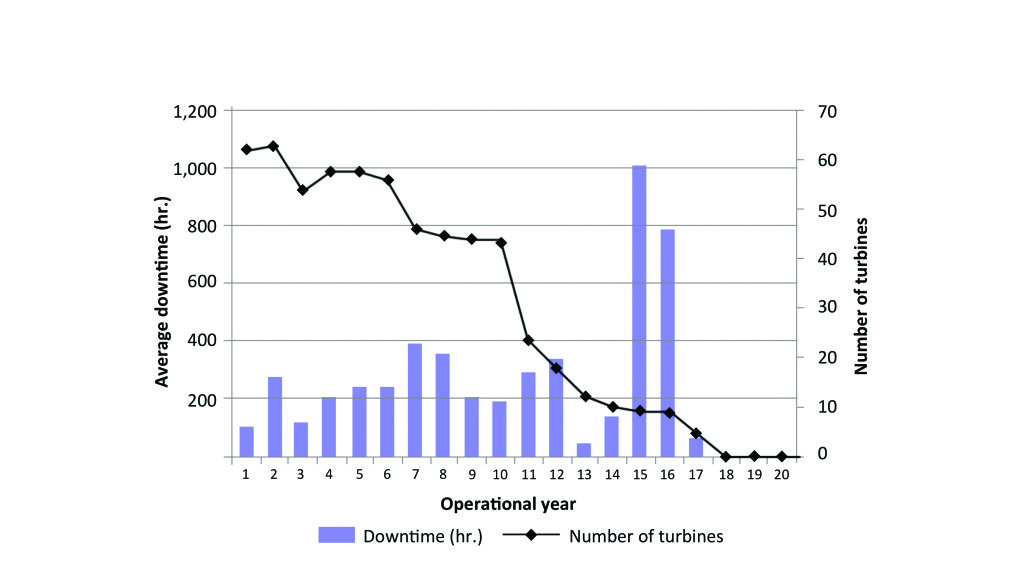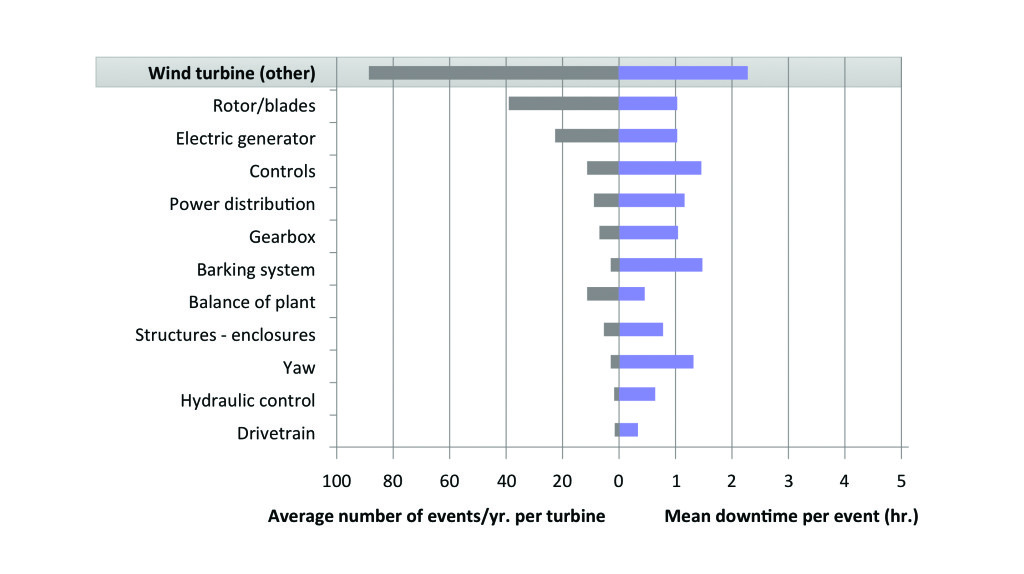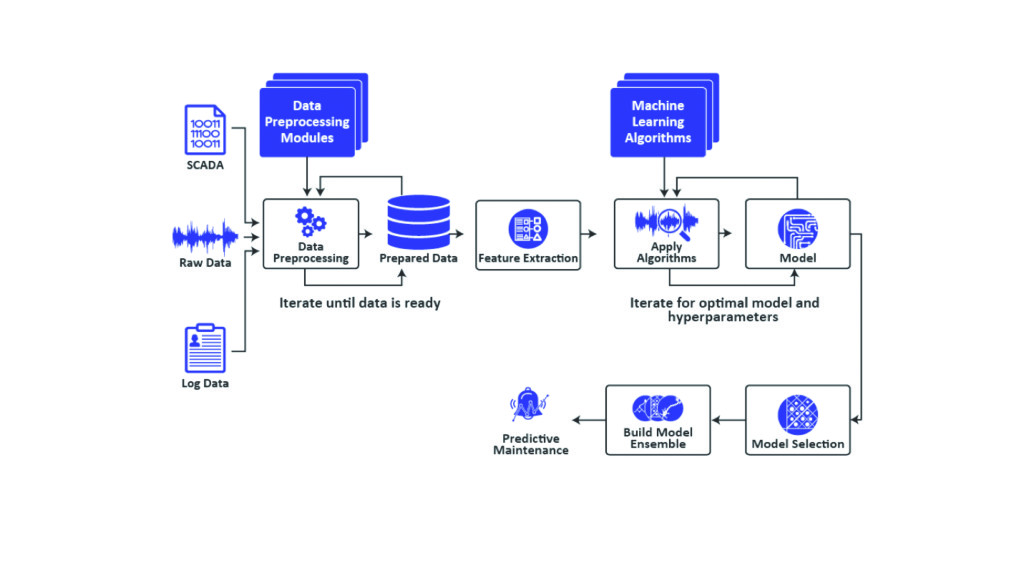Consider Automated Machine Learning for Wind Turbine Asset Maintenance
The potential financial benefits from Industry 4.0 are apparent to plant owners in almost all sectors. The wind power industry is no exception, and existing vendors such as GE (Predix/Digital Windfarm), Siemens, and SAP are investing heavily in research and development (R&D) in this area. Given the number of sites and the remote locations of wind farms, there is compelling economic benefit from using machine learning to predict asset failure.
Operations and maintenance (O&M) account for up to 30% of the levelized cost per kWh produced over the lifetime of a turbine. Although estimates vary, average forced or unscheduled wind turbine shutdown is between seven and nine days a year. For example, unplanned turbine shutdown caused by a faulty gearbox can result in four to eight weeks of turbine downtime, and could cost $130,000 to replace. More than 70% of wind turbine downtime is for major repairs, with the remaining 30% split between minor repairs (17%) and manual restart (11%).
The O&M costs on new turbines are relatively low and typically covered by service agreements. As shown in Figure 1, as assets age, there is a significant increase in maintenance expenditures.
Because of the remote locations of most wind turbines, crane rental expenses are a major component of asset and parts replacement costs. In fact, it takes far less time to repair a generator than it does to transport it. Asset failure results in turbine downtime during the waiting periods, especially when weather conditions and site conditions such as icing can impact time-to-repair.
Traditional Predictive Maintenance Limitations
The default asset maintenance solution for wind turbines is the traditional predictive maintenance (PdM), or condition monitoring (CM), based on supervisory control and data acquisition (SCADA) data. Sensor data from turbines is monitored, and if control thresholds are breached, alerts are generated to operational maintenance staff.
There are two major challenges that wind farms experience when using CM based on SCADA data. First, PdM using SCADA data is based on manually set control limits. The system will recognize a change in machine vibration or temperature only if it breaches the predefined limits. However, abnormal sensor behavior within the control limits is not identified.
Second, only the most critical asset sensor data is monitored due to bandwidth constraints. Figure 2 shows that the four top identifiable drivers of failure and downtime are rotor/blades, electric generators, balance of plant, and controls. However, the most significant contributing factor is unknown—the “other” category.
In other words, there is no actual visibility into the largest cause of downtime. Only high priority and mission critical asset sensor data is monitored. Furthermore, there is no systematic way to identify the root cause of a failure. By monitoring each asset independently, the traditional PdM method fails to recognize patterns of sensor behavior or correlative behavior.
Unsupervised Machine Learning for Asset Maintenance
Until recently, machine learning was in the domain of academia. However, the application of artificial intelligence (AI) and algorithms is now fueling advances in the Industrial Internet of Things (IIoT). The term “unsupervised” indicates that the algorithms do not need to be trained on the underlying asset that is monitored. There is no need to use a simulated clone of the physical asset, such as a “Digital Twin.”
To apply machine learning to asset maintenance, turbine asset sensor data is continuously streamed to the cloud where AI algorithms analyze it in real time. Of course, this assumes real-time communications links, which will need to be considered for remote locations.
The algorithms are trained to detect anomalies in all the asset’s signals. Correlations and pattern detections among signals are performed. Instead of looking for breaches of manually set control limits, the algorithms detect abnormal behavior that is indicative of asset degradation and failure.
Automated Model Selection
One of the challenges with machine learning is the selection of the algorithm used to detect the abnormal sensor behavior that is indicative of machine degradation or failure. In the past, there was reliance on data scientists to select the most relevant model from a library of algorithms. However, with the massive amount that must be analyzed in real time, the ability to automatically select an algorithm is critical.
In the case of Presenso, our automated machine and deep learning (MDL) engine (Figure 3) selects the optimal algorithms and hyperparameters in a data-driven way without any human intervention. The auto-MDL includes dozens of machine learning algorithms, tens of preprocessing methods, and all their respective hyperparameters, yielding a total of hundreds of hyperparameters. This process is enabled by computational power of the cloud.
Machine and Sensor Agnostic
One of the overlooked advantages of unsupervised machine learning is that it is machine or sensor agnostic. This means a wind turbine can have more than 8,000 unique components, ranging from hydraulic systems and power converters to fall protection. As long as sensor data is generated, the machine learning algorithm analyzes all the signal data and detects abnormal patterns without consideration of the following:
■ Asset age. The algorithm does not differentiate whether the turbine is two years old or 15 years old.
■ Vendor. Vendor information is not relevant to the performance of the algorithm. Therefore, sensor data from the following manufacturers can be analyzed: Acciona, Alstom, Dongfang, Enercon, Gamesa, GE Energy, Goldwind, Nordex, Repower, Siemens, Sinovel, Suzlon, and Vestas. Note that both GE (Predix) and Siemens (MindSphere) are also major players in the so-called Digital Twin market. The impact is that a single solution can be applied to all turbine types without the need for multiple vendor-specific systems.
■ Part or asset type. All sensor data from all the following assets can be analyzed, including blades, gearbox, generator, and coupling and bolt tightness.
■ Onshore versus offshore. The algorithm does not differentiate between offshore and onshore facility location.
The Impact of Machine Learning on Asset Maintenance Costs
As asset reliability increases, there is less money spent on reactive maintenance. Conversely, an underinvestment in predictive and preventive maintenance increases the need for reactive maintenance caused by unplanned machine breakdown.
When machine learning algorithms detect asset degradation and breakdown ahead of time, resources can be shifted away from over-reliability investments such as unnecessary maintenance. As asset reliability investments are rationalized and the detection of degradation is improved, the frequency of unscheduled downtime is reduced. This lowers total maintenance cost as a percentage of replacement asset value.
The unsupervised machine learning solution for asset maintenance applies the latest advances in AI to detect abnormal data patterns throughout an entire facility, thereby lowering the cost of reliability maintenance. A cloud-based solution does not require new hardware or sensors and can be deployed remotely, without the need for human input from facility staff.
Based on estimates from Germany, the UK, and Denmark, O&M costs are estimated to be between 1.2 c€ and 1.5 c€ per kWh of wind power produced, over the total lifetime of a turbine. In the U.S., O&M costs are less expensive (best practice is $0.01 per kWh). Between 43% and 54% of this is allocated to overhead, administrative costs, insurance, and rental income. Applying machine learning to the asset maintenance mix to reduce replacement part and labor costs has the potential to significantly impact the financial performance of a wind farm.
The cost savings for maintenance and labor can be extensive. Using both U.S. and European data, a 20% reduction in the repair and maintenance portion of O&M (assumed to be between 46% and 57% of overall O&M costs) would yield annual cost savings of $11,383 for a 2.5-MW turbine and $34,148 for a 7.5-MW turbine.
Limiting O&M expenses is a high priority for the wind power sector. If executed effectively, wind farm operators can now use automated machine learning to turn under-utilized sensor data into a way to lower overall turbine asset maintenance costs. ■
–Eitan Vesely is CEO of Presenso.


